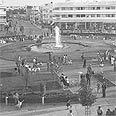
Dizengoff Square, Tel Aviv
צילום: לע"מ
A Tour of the White City
None
TEL AVIV - Shula Vidrich, a veteran Tel Aviv tour guide, recommends taking this short tour in the footsteps of Bauhaus architecture.
The tour sets out from the heart of Tel Aviv between King Solomon Street and Dizengoff Square, and moves westwards towards a cluster of Bauhaus buildings, some of which have been renovated and others restored.
The tour begins at the Roznosar house on 5 Yael Street, on the corner of 27 King Solomon Street. This residential building is cubical, with an abundance of carefully designed detail. The exterior of the building is dotted with small terraces, some face Yael Street and others overlook the corner of King Solomon Street. The terraces encircle the building projecting a ring of shade around it.
The wall around the entrance is covered in ceramic tiles and the stairwell is marked by glass tiles and round windows reminiscent of a ship's port-hole.
The next stop is at "Ruth's Garden", which has survived as a recreational area despite its location in the heart of a residential area, as originally designed by Bauhaus architect Geddes in the 1930's. The garden is fenced in by a row of trees. During its heyday the garden was in full bloom, sadly this is not the case today.
A rectangular fish pond with gold fish swimming among the water lilies used to be located the center of this garden.
From here we turn left to Shulamit Street and then right to Zamenhof Street towards Zina Dizengoff Square.
The Square was designed by Russian born architect Genia Averbuch and was built during 1934-1949. It was Tel Aviv's first square to incorporate architectural elements. A glance at the houses surrounding the square reveals their original design.
They are encircled by long terraces that shade the areas surrounding the building. The square used to boast a round shaped water fountain, surrounded by rings of grass, gravel, trees and foot paths that led into the adjoining streets.
Two movie theatres, Chen and Esther, were built in the square, designed by architect Yehuda Megirovitch. When first opened, the Esther movie theatre housed 1,000 seats. It had a lobby, a coffee house and a department store on the ground floor.
The terraces create a circular and horizontal flow that complements the square's overall design. The perpendicular emphasis is created by a smooth wall on the corner of the building, which was once used for hanging signs.
The Esther theatre was opened in 1939 and its first screening was Walt Disney's “Snow White and the Seven Dwarfs.” Several years later it underwent a transformation and turned into the Cinema Hotel.
The hotel is built in pure Bauhaus style and its renovation adhered to strict landmark preservation guidelines, transforming it into a striking boutique hotel with 83 stylized guest rooms, most with a terrace.
The lobby is well worth visiting to see the design inspired by the world of cinema. Antique film projectors, movie posters and original theater seats pose as environmental sculptures.
The original curved staircase still soars five floors high, lit by ground-to-roof Bauhaus windows.
The tour ends here, but there are more than 4,000 Bauhaus-style buildings in Israel.
For more guided tours visit: http://www.gemsinisrael.com/telavivtours.html










